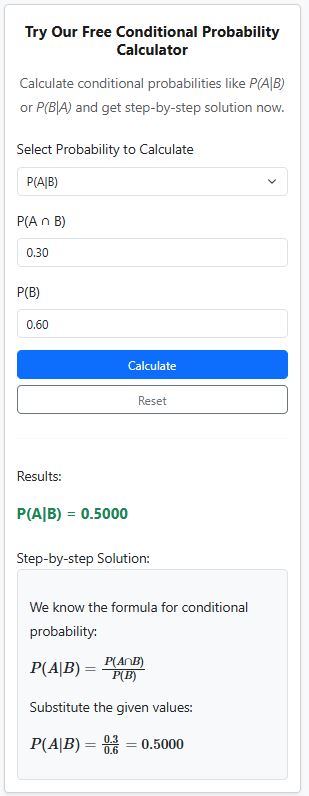The Conditional Probability Calculator computes the probability of Event A happening, given that Event B has already happened (i.e. the conditional probability of A given B has happened) and vice versa. It also provides a step-by-step explanation showing how to compute the conditional probability.
Easily calculate conditional probabilities, P(A|B) and P(B|A), using this free calculator.
How the Calculator Works
Finding conditional probability with the calculator is simple and fast. You don’t need to memorize formulas because the calculator does all the work for you. You only need to:
- Select the probability you want to find (select either P(A|B) or P(B|A) )
- Enter the required values:
- The joint probability of both events, P(A and B).
- The probability of P(A) or P(B), depending on your choice.
- Click “Calculate” button
The calculator will show you the result and a step-by-step explanation of how to compute the conditional probability.
What is Conditional Probability?
Conditional probability is the likelihood of an event occurring, given that another event has already occurred. It is written as P(A|B) and is calculated by dividing the probability of both events A and B happening by the probability of event B happening. This concept is used when events are dependent. In other words, it works when the outcome of one event affects the outcome of another, such as drawing two cards from a deck
Let’s assume we have two events, A and B. If the probability of A changes when B occurs, then A and B are called dependent events. This dependency is what conditional probability measures. In simple terms, conditional probability tells us the chance that Event A happens given that Event B has already happened. Thus, the conditional probability formula for event A happening given that B has already occured is:

This means the probability of A given B equals the probability that both A and B happen, divided by the probability that B happens.
Similarly, the conditional probability formula for event B happening given that A has occured is:

Where:
- P(A) is the probability that Event A occurs.
- P(B) is the probability that Event B occurs.
- P(A and B) is the probability that both A and B occur together.
For example, if A is the event that “it rains” and B is the event that “the sky is cloudy,” then P(A|B) represents the chance of rain, given that the sky is cloudy. These two events are dependent, because the chance of rain changes when you know the sky is cloudy.
However, if these two events are independent, then the occurrence of one does not affect the other. In that case:
P(A∣B)=P(A) and P(B/A) = P(B)
Finding Conditional Probability Manually: Example
Conditional probability becomes easier to understand when we use real-world examples. It helps us find how likely one event is to happen after another event has already occurred. Let’s go through an real-world examples to see how it works in practice.
Scenario: A hospital conducted a study to see the relationship between symptom A and test B.
They found that:
- 30% of patients had both symptom A and a positive test B result.
- 60% of patients tested positive for test B.
Using this information, what is the probability that a patient has symptom A given that they tested positive for test B?
Solution
Let:
- A be the event patients had symptom A
- B be the event that patients test positive for event B
From the scenario, then P(A and B) = 0.30 and P (B) = 0.60
Applying the conditional probability formula, we have:
$P(A|B) = \frac{P(A \text{ and } B)}{P(B)}$
Substituting the known probabilities in the formula, we have:
$P(A|B) = \frac{0.3}{0.6}$
=0.5
Interpretation: There is a 50% chance that a patient has symptom A, given that they tested positive for test B.
Alternatively, using our free conditional probability calculator, you get similar results with step-by-step explanations, as shown below:

Frequently Asked Questions
A Conditional Probability Calculator is an online tool that helps you find the probability of one event occurring given that another event has already happened. It calculates values like P(A|B) or P(B|A) and shows the step-by-step solution using the correct formula.
You can calculate conditional probability using the formula:
P(A|B) = P(A and B) * P(B).
This means you divide the probability of both events happening (P(A and B)) by the probability of the given event (P(B)).
– P(A|B) means the probability that event A occurs given that event B has already occurred.
– P(B|A) means the probability that event B occurs given that event A has already occurred.
Note that these two values are not always the same. They depend on which event is known first.
You should use a conditional probability solver when you need to find the relationship between two dependent events. It is especially useful in subjects like statistics, data analysis, probability theory, and even in real-life situations such as medical testing or risk assessment.
P(A and B) represents the joint probability. In other words, it is the likelihood that both events A and B occur together. It is used in the conditional probability formula to calculate either P(A|B) or P(B|A).
The step-by-step dependent probability calculator not only gives the final answer but also shows how it was calculated. It explains each step clearly, making it easier for students, teachers, and professionals to understand how to find conditional probability using real examples and simple formulas.